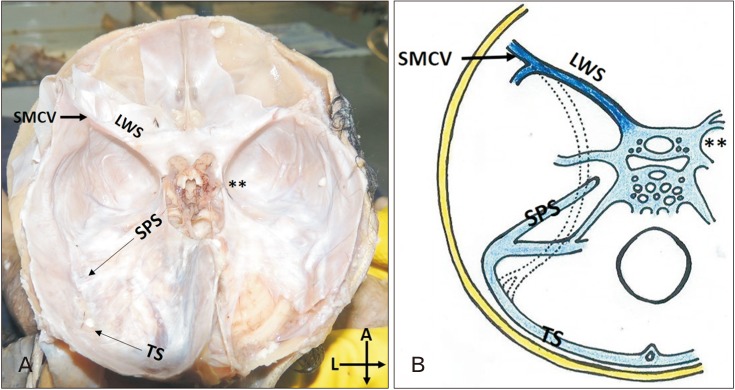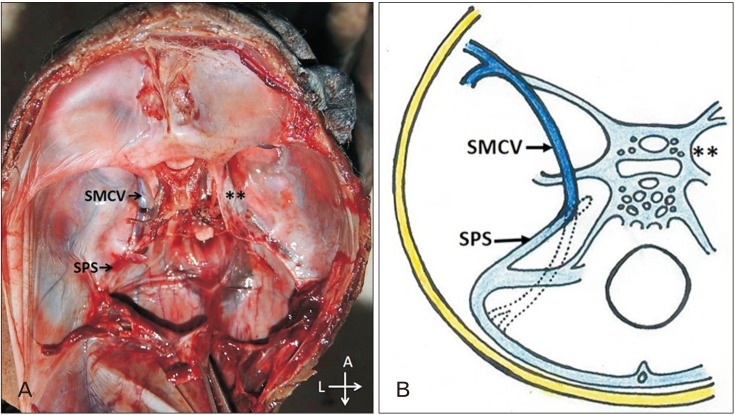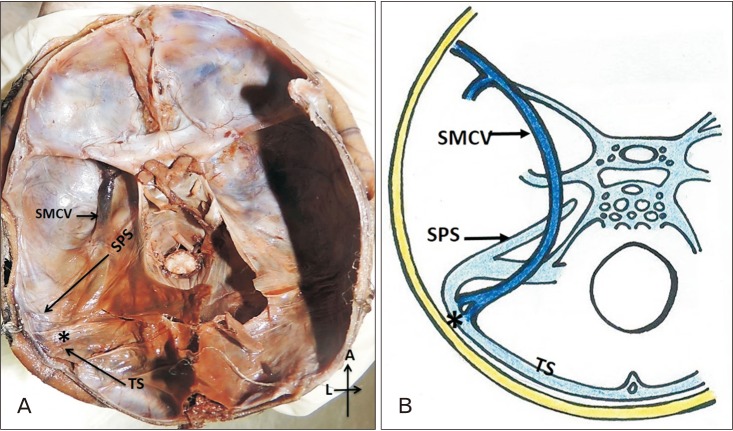Abstract
The superficial middle cerebral vein (SMCV) drains the venous blood from most of the superolateral surface of the brain and drains typically into the cavernous sinus as mentioned in standard textbooks. But the drainage of the SMCV is variable as indicated by various radiological studies. Although variations in the drainage of the SMCV exist, there is a shortage in the literature providing cadaveric evidence for the same. The present study was designed to identify the variations in the drainage pattern of the SMCV in fetal cadavers. During the dissection of formalin-fixed full-term fetuses, deviation in the drainage of the SMCV was observed in five out of 30 cases. In three out of 30 specimens (10%), SMCV was observed draining into superior petrosal sinus; and in two specimens (6.6%) into the transverse sinus. In the remaining specimens, the SMCV drained directly into the cavernous sinus. Knowledge of the variations noted in the present study is essential, not only for diagnosing several diseases involving the cavernous sinus or paracavernous sinuses but also in surgeries of paracavernous sinus lesions and endovascular treatment of arteriovenous fistulas. The SMCV and superior petrosal sinus can be a venous refluxing route in patients with arteriovenous fistulas.
Venous drainage of the cerebrum is expertly modulated by highly complex superficial and the deep cerebral veins. These veins anastomose with each other and drain into the major dural venous sinuses such as superior sagittal (SSS), inferior sagittal, transverse (TS), cavernous (CS), and straight sinuses. All these sinuses ultimately drain into the internal jugular vein (IJV) [12].
The superficial middle cerebral vein (SMCV) is one of the superficial veins of the cerebrum that drains the venous blood from most of the superolateral surface of the brain. The SMCV lies in the posterior horn of the lateral sulcus, which further course along the lateral sulcus, pterion, lesser wing of sphenoid to drains into the CS [34]. Interestingly, with the help of many angiographic studies, several deviations from the normal course have been observed. The knowledge of these variant courses is vital so that different surgical approaches can be applied to prevent bleeding. The termination of the SMCV and its association with the skull base is imperative in the preoperative planning of the skull base surgery [3].
Studies in the past have focused on the variant pattern of the SMCV and attempted to classify the same. However, most of them were computed tomography (CT) angiography based studies [35]. Very few cadaveric studies on the variant pattern of the SMCV is available in the existing literature in adults and fetuses alike. Here in this study, we have made a sincere attempt to classify the various anatomical variations in the termination of SMCV in the termed fetus.
For the present study, 30 full-term fetuses (13 males and 17 females) obtained from the medical termination of pregnancies from the OBG department, Kasturba Medical College Manipal, were utilized. The crown rump length of the fetus was measured, the cranial cavity was dissected meticulously, and the dural venous sinuses were observed. The variation in the drainage pattern of the SMCV was noted and photographed. The SMCV was identified and classified based on its variability using a standard reference [3].
In the present study five specimens presented with variation in the pattern of the drainage of SMCV. Rest of the specimens had a typical presentation, i.e., sphenoparietal type as described previously (83.4%) (Fig. 1) [3]. The five cases fall into the two categories of the previously proposed classification, i.e., the superior petrosal (3 cases, 10%) and the basal type (2 cases, 6.6%). Interestingly in all the cases, the variations were seen on the left side.
The SMCV was coursing along the lesser wing of the sphenoid. It further passed downward and backward along the middle cranial fossa almost parallel to the CS to drain into the anterior end of the superior petrosal sinus (SPS) (Fig. 2).
The SMCV was passing along the Sylvian fissure and the lesser wing of the sphenoid (LWS). It then turned abruptly downwards and posteriorly along the middle cranial fossa, lateral to the CS. It later crossed the junction between TS and the Sigmoid Sinus and finally drained into the TS (Fig. 3). The communicating channels observed in these specimens were wider and more prominent than the other venous sinuses.
A definitive venous pattern of the head and neck region develops in the first three months of prenatal life [67]. Two embryological sinuses, i.e., tentorial sinus and the prootic sinus take part in the formation of SMCV. Subsequent growth of cerebral hemisphere leads to elongation of the tentorial sinus. The SMCV is formed due to the medial shift of the anterior portion of the tentorial sinus into the CS. The segment of the tentorial sinus distal to it regress leading to the adult/definitive pattern of the SMCV. Fail in the medial shift/regression of the tentorial sinus results in the anomalous course and termination of SMCV [8].
The SMCV runs typically along the LWS bone and enters into the proximal SPS. However, San Millan Ruiz et al. [9] have raised a question regarding the drainage of the SMCV into the SPS in an anatomic study using an autopsied cadaver.
Suzuki and Matsumoto in 2000 [3] classified the drainage of SMCV into seven types based on embryological development or the remnant of the TS. The classification was done using a three-dimensional CT angiography and, 500 SMCVs were evaluated in 250 adult patients. The seven types included sphenoparietal (54%), cavernous (7%), emissary (12%), superior petrosal (2%), basal (2%), squamosal (2%), and underdeveloped (9%). It was not possible to confirm the drainage pattern in 8 % of the cases. 3% of the cases showed multiple drainage pathways as observed in their study [3]. In the present study in fetuses, only three types of the drainage pattern of the SMCV was observed, i.e., superior petrosal type in 10% and basal in 6.6% of the cases respectively. The remaining 83.4% of the cases were of the sphenoparietal type. The frequency of atypical SMCV's, i.e., superior petrosal and basal type was more in the fetuses as was observed in the present study unlike in the adults. The incidence of both types was rare/less in adults. It could be because the fetuses born with the types above may not survive postnatal.
The basal type of SMCV as observed in the present study results due to the persistence of the entire venous route of tentorial sinus. Thus the SMCVs routed via the sphenoparietal sinus and turned laterally along the floor of the middle cranial fossa, running along the petrous pyramid to terminate in the TS. The caudal regression of the primitive tentorial sinus is the result of the communication of the tentorial sinus to SPS leading to in superior petrosal type of the sinus [7].
A large rare squamousal type of vein running along the inner surface of temporal squama, connecting SMCV to into TS is reported by Kumar et al. in 2012 [8]. An unusual oblique sinus, which connected the right and the left TS was also reported previously [2].
In the dural arteriovenous fistulae (DAVF), the venous collaterals and venous rerouting help in the drainage of CS to the SPS, which then drains away into the cortical veins. These findings suggest that postnatal secondary anastomosis between the SPS or the TS and any possible remnant variations of the SMCVs could be a potential route of venous rerouting or collaterals in DAVFs [1011].
The basal type of venous drainage limits the temporal lobe mobility in the subtemporal approaches in neurosurgery. It is because the vein tightly adheres to the middle cranial fossa. In this situation, the collateral venous outflow patterns must be evaluated, and a different operative approach should be considered to reduce the likelihood of possible venous complications [12].
Gailloud et al. [13] performed a study on the termination pattern of SMCV. In their study, the SMCV was found to be absent in 19% of the cases. When present, they found the SMCV terminating directly into the CS in 20% of cases, the paracavernous sinus in 39% of cases, and the laterocavernous sinus in 22% of cases. Further, they also found that the paracavernous and laterocavernous sinuses drain into SPS in 33% and 18% of the cases respectively, which is the second most frequent type. Normally the paracavernous and laterocavernous sinuses drain into the pterygoid plexus [13].
The variation in the venous pattern as is observed in the present study in case of SMCV may also indicate the defective development of the IJV and the related venous sinuses. Identification of these variant veins is therefore essential in surgeries to avoid the dangerous catastrophic hemorrhage [14].
A variant of the SMCV mimicking an extra-axial hematoma has been reported. Herein the patient presented with an underdeveloped type of SMCV that was drained by a large venous channel into the SSS [1]. Variation in the course of SMCV should be considered and screened by angiogram before the surgery to reduce the risk during surgical procedures and the possibilities of post-operative edema [15].
Knowledge of the variations in the drainage of the SMCV as observed in the present study in fetal cadavers is essential for diagnosing several diseases involving the CS or paracavernous sinuses. It is also important in the correction of the lesions of the para-cavernous sinus and endovascular treatment of arteriovenous fistulas. The SMCV and SPS can serve as a venous refluxing route in patients with arteriovenous fistulas.
References
1. Saigal G, Villalobos E. A variant of the superficial middle cerebral vein mimicking an extraaxial hematoma. AJNR Am J Neuroradiol. 2003; 24:968–970. PMID: 12748104.
2. Srijit D, Shipra P. Unusual venous sinuses. Bratisl Lek Listy. 2007; 108:104–106. PMID: 17685011.
3. Suzuki Y, Matsumoto K. Variations of the superficial middle cerebral vein: classification using three-dimensional CT angiography. AJNR Am J Neuroradiol. 2000; 21:932–938. PMID: 10815671.
4. Chung JI, Weon YC. Anatomic variations of the deep cerebral veins,tributaries of Basal vein of rosenthal: embryologic aspects of the regressed embryonic tentorial sinus. Interv Neuroradiol. 2005; 11:123–130. PMID: 20584491.
5. Fukuda M, Saito A, Takao T, Hiraishi T, Yajima N, Fujii Y. Drainage patterns of the superficial middle cerebral vein: effects on perioperative managements of petroclival meningioma. Surg Neurol Int. 2015; 6:130. PMID: 26322240.
6. Knosp E, Müller G, Perneczky A. Anatomical remarks on the fetal cavernous sinus and on the veins of the middle cranial fossa. In : Dolenc VV, editor. The Cavernous Sinus. Vienna: Springer;1987. p. 104–116.
7. Padget DH. The cranial venous system in man in reference to development, adult configuration, and relation to the arteries. Am J Anat. 1956; 98:307–355. PMID: 13362118.
8. Kumar A, Chandra PS, Mankotia DS, Tripathi M, Garg A, Mahapatra AK. Squamosal type superficial middle cerebral vein: a rare venous drainage pattern. Neurol India. 2012; 60:546–547. PMID: 23135048.
9. San Millan Ruiz D, Fasel JH, Rufenacht DA, Gailloud P. The sphenoparietal sinus of breschet: does it exist? An anatomic study. AJNR Am J Neuroradiol. 2004; 25:112–120. PMID: 14729539.
10. Willinsky R, Goyal M, terBrugge K, Montanera W. Tortuous, engorged pial veins in intracranial dural arteriovenous fistulas: correlations with presentation, location, and MR findings in 122 patients. AJNR Am J Neuroradiol. 1999; 20:1031–1036. PMID: 10445439.
11. Stiebel-Kalish H, Setton A, Nimii Y, Kalish Y, Hartman J, Huna Bar-On R, Berenstein A, Kupersmith MJ. Cavernous sinus dural arteriovenous malformations: patterns of venous drainage are related to clinical signs and symptoms. Ophthalmology. 2002; 109:1685–1691. PMID: 12208718.
12. Sakata K, Al-Mefty O, Yamamoto I. Venous consideration in petrosal approach: microsurgical anatomy of the temporal bridging vein. Neurosurgery. 2000; 47:153–160. PMID: 10917358.
13. Gailloud P, San Millán Ruíz D, Muster M, Murphy KJ, Fasel JH, Rüfenacht DA. Angiographic anatomy of the laterocavernous sinus. AJNR Am J Neuroradiol. 2000; 21:1923–1929. PMID: 11110548.
14. Murlimanju BV, Chettiar GK, Prameela MD, Tonse M, Kumar N, Saralaya VV, Prabhu LV. Mastoid emissary foramina: an anatomical morphological study with discussion on their evolutionary and clinical implications. Anat Cell Biol. 2014; 47:202–206. PMID: 25276480.
15. Dean BL, Wallace RC, Zabramski JM, Pitt AM, Bird CR, Spetzler RF. Incidence of superficial sylvian vein compromise and postoperative effects on CT imaging after surgical clipping of middle cerebral artery aneurysms. AJNR Am J Neuroradiol. 2005; 26:2019–2026. PMID: 16155152.
Fig. 1
Drainage pattern of superficial middle cerebral vein (SMCV)-sphenoparietal type. (A) The SMCV draining into the cavernous sinus on the left side. Symbol ** represent the location of the right cavernous sinus. (B) Schematic representation of the drainage pattern of SMCV-sphenoparietal type. The Interrupted lines represent the regression of the tentorial sinus (TS). LWS, lesser wing of sphenoid; SPS, superior petrosal sinus.

Fig. 2
Drainage pattern of superficial middle cerebral vein (SMCV)-superior petrosal type. (A) The SMCV draining into the superior petrosal sinus (SPS) on the left side. This pattern of drainage of SMCV was observed in three cases (10%). Symbol ** represent the location of the right cavernous sinus. (B) Schematic representation of the drainage pattern of SMCV-superior petrosal type. The Interrupted lines represent the regression of the tentorial sinus.

Fig. 3
Drainage pattern of superficial middle cerebral vein (SMCV)-basal type. (A) The SMCV draining into transverse sinus (TS). This pattern of drainage of SMCV was present in 2 (6.6%) of the cases. Symbol * represents the junction of the drainage of the SMCV into TS. (B) Schematic representation of the drainage pattern of SMCV-basal type. SPS, superior petrosal sinus.





 PDF
PDF ePub
ePub Citation
Citation Print
Print



 XML Download
XML Download